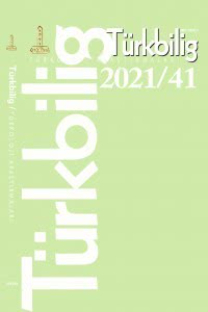IDENTITY PERCEPTION AND HIDDEN CURRICULUM IN THE COURSEBOOKS TEACHING TURKISH AND ENGLISH AS A FOREIGN LANGUAGE
Yabancı dil öğretiminde kullanılan ders kitaplarında materyal oluşturma sürecindeki gizli müfredatın bir parçası olan kimlik algısı ve sunumu ve yazarların kimi toplum-kültürel konulara tutumları konusu, bu ders kitaplarının sadece bir yabancı dili öğretmekle kalmayıp, aynı zamanda öğrenenlerin dünya görüşünü de değiştirmesi ya da şekillendirmesi sebebiyle araştırılmaya değerdir. Bu çalışmada, Türkçenin ve İngilizcenin yabancı dil olarak öğretildiği ders kitaplarından seçilmiştartışmacı metinler içindeki gizli müfredat kullanımı ile ideoloji ve kimlik oluşturma çabaları Taifelin (1979) ToplumsalKimlikKuramıveTutumAnalizi(Liu,2012)sayıltılarından faydalanarak araştırılmıştır. Çözümleme için, her iki ders kitabından aynı konuları irdeleyen tartışmacı metinler seçilmiş ve karşılaştırılmıştır.Bukarşılaştırmaüçaçıdangerçekleştirilmiştir: Kimlik algılama ve sunumu, Biz ve onlar ayrımı, metin içinde belirli konu ya da kavrama karşı gösterilen olumlu/ olumsuz ya da nesnel tavır/tutum. Ders kitaplarında ortaya çıkarılacak olan bu tür bir uygulamayadadayatmanın,öğrenenlerüzerindekietkilerininfarkındaolmalarıgerekenyabancıdilöğretmenleri,öğretim elemanları, yöneticiler ve program geliştirenler için önemli olduğu düşünülmektedir.
Türkçe nin ve İngilizce nin Yabancı Dil Olarak Öğretildiği Ders Kitaplarında Kimlik Algısı ve Gizli Müfredat
Identity perception, presentation and attitudes as part of hidden curriculum in foreign language teaching coursebooks are worth examining due to the fact that they do not only teach a foreign language, but also change or shape world view of the learners implicitly. In this study, we aim to explore any possible hidden ideology and identity construction efforts in the argumentative texts selected from TFL (Turkish as a foreign language) and EFL (English as a foreign language) coursebooks making use of the premises of Social Identity Theory (SIT) by Taifel (1979) and Sentiment Analysis (Liu, 2012). For the analysis, several argumentative texts sharing the same topic from the two coursebooks were purposively selected and compared. The texts were analysed in three aspects: Identity perception and presentation ,Us and Them Distinction and Positive/Negative/Neutral Attitudes towards particular themes/notions in the texts Any ideological imposition or bias in the coursebooks was thought to be significant for language teachers, instructors, administrators and curriculum developers who must be aware of the probable implicit mechanism that affects the learners in the coursebooks.
___
- AUERBACH, E. and D. BURGESS, (1985), The hidden curriculum of survival ESL, TESOL Quarterly 19/3: 47595.
- LİU,B. (2012), Sentiment Analysis and Opinion Mining, Morgan & Claypool Publishers.
- ..........., (2015), Opinions, Sentiment, and Emotion in Text,Cambridge University Press,
- CUNNİNGSWORTH, A., (1986), Evaluating and Selecting EFL Teaching Materials, Oxford: Heinemann.
- ..........., (1995), Choosing Your Coursebook, Oxford: Heinemann.
- DİCKERSON, L. (2007), A Postmodern View Of The Hidden Curriculum, Unpublished Doctoral Dissertation Georgia Southern University. USA
- HURST, N. R., (2015), The Hidden Curriculum: issues and angst about cultural content in ELT materials, http://web.letras.up.pt/nrhurst/Hidden%20Curriculum%20Article%20-%20Valladolid.pdf on 7th Sept. 2015
- HUTCHİNSON, T. & Torres, E., (1994), The Textbook as Agent of Change, ELT Journal, 48(4): 315-328.
- MCLEOD, S., (2011), Simply Psychology. Social Identity Theory, Retrieved on June 16th , 2015. http://www.simplypsychology.org/social-identity-theory.html
- NDURA, E., (2004), ESL and cultural bias: An analysis of elementary through high school textbooks in the western United States of America, Language, Culture, and Curriculum, 17(2): 143-153.
- POSNER, G.J., (2004), Analyzing the curriculum, (3rd ed.), NY: McGraw-Hill.
- SKELTON, A., (1997), Studying hidden curricula: Developing a perspective in the light of postmodern insights, Curriculum Studies. 5 (2), Retrieved July 2, 2015, from http://homes.chass.utoronto.ca/~tkennedy/Courses/38H3/Skelton.pdf
- TELÇEKEN, M., (2014), The Presentation of the Target Culture in the Coursebooks Teaching Turkish and English as a Foreign Language: Hidden Curriculum, Unpublished Masters Thesis Başkent University. Ankara
- TARSHİS, D., (2008), Measuring Whats Hidden How College Physics Courses Implicitly Influence Student Beliefs. Unpublished Doctoral Dissertation. Colorado University. US.
- TAİFEL, H., (1974), Social Identity and Intergroup Behaviour. Social Science Information. 13: 65-93.
- ..........., (1979), Individuals and groups in socal psychology. British Journal of Social and Clinical Psychology, 18: 183-190.
- WOJCİECH, Żmudziński SJ., (2007), Hidden Curriculum as an Opportunity to Create a Better School Climate Pedro Arrupe Formation Center for Educational Leaders, Poland. http://www.fbsc-net.eu/abstract/Abstract%20Wojciech%20Zmudzinski.pdf
- WATSONS,J., (2015), Attitudes and Values, Retrieved on 10 September, 2015 from http://johnwatsonsite.com/MyClassNotes/Topics/Attitudes%20and%20Values/AttitudesandValuesHome.html)
- VAN DİJK, T. A., (1998), Ideology: A Multidisciplinary Approach. SAGE Publications Ltd.
- ISSN: 1302-6011
- Yayın Aralığı: Yılda 2 Sayı
- Başlangıç: 2000
- Yayıncı: Doç. Dr. Bülent Gül
Sayıdaki Diğer Makaleler
Nuray ALAGÖZLÜ, Merve TELÇEKEN
ANADOLU SAHASI KÖROĞLU HAVALARI: KARŞILAŞTIRMALI BİR DENEME
KONSTANTİN İVANOV'UN ŞİİRLERİNDE BİTMEYEN MÜCADELE : İYİ-KÖTÜ ÇATIŞMASI
KARLOFÇA ANTLAŞMASI'NA DOĞRU MACARİSTAN'IN SİYASİ VE SOSYAL VAZİYETİ İZİNDE İKİ OSMANLI VESİKASI
MUSKANIN TARİHSEL VE İŞLEVSEL AÇIDAN DEĞERLENDİRİLMESİ VE BU BAĞLAMDA ZEYNEDDİN BABA ÖRNEKLEMİ
MOR SALKIMLI EV'DE YAZARIN BİLİNCİ
SÖZCÜK DÜZEYİNDE KABALIK-ÖRTMECE KELİME VE ARGO KULLANIMININ İLETİŞİMDEKİ İŞLEVLERİ VE KATEGORİLERİ
DEDE KORKUT HİKÂYELERİ'NDE BENLİK, KİMLİK, KİŞİLİK ÜÇGENİNDE DEVLETLÜ OĞUL, YİĞİT VE EREN
